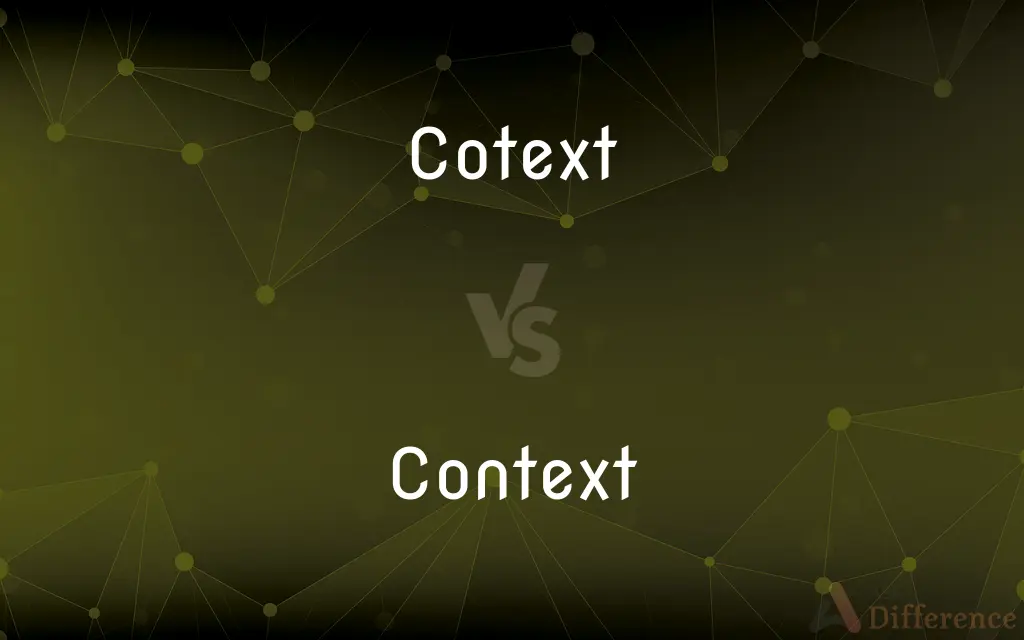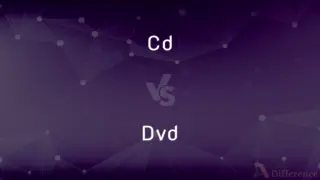Cotext vs. Context — What's the Difference?
By Maham Liaqat & Fiza Rafique — Updated on March 31, 2024
Cotext refers to the text surrounding a word or phrase, influencing its meaning, while context encompasses all circumstances or factors that give meaning to a situation, including cotext.

Difference Between Cotext and Context
Table of Contents
ADVERTISEMENT
Key Differences
Cotext specifically denotes the surrounding text or words that contribute to the meaning of a particular word or phrase within the same text. It is a linguistic term focusing on textual elements that affect interpretation. In contrast, context is a broader term that includes not only the cotext but also the situational, cultural, and background factors influencing the understanding or interpretation of a text or situation.
While cotext is confined to the textual environment immediately surrounding a word or phrase, context extends beyond the text to include external factors such as the author’s background, the audience’s pre-existing knowledge, cultural norms, and the situation in which the communication occurs. This means that while cotext is a subset of context, context encompasses a much wider range of elements that can affect interpretation.
Cotext plays a crucial role in semantics and syntax within language studies, helping linguists and readers understand how words and phrases derive specific meanings from their textual relationships. On the other hand, context is used across disciplines, including linguistics, anthropology, psychology, and more, to understand how various factors influence meaning, perception, and behavior in broader scenarios.
Understanding cotext is essential for accurate textual analysis and translation, as it helps identify the meanings of ambiguous words or phrases based on their immediate textual environment. However, understanding context is crucial for comprehensive interpretation, as it involves recognizing all relevant external factors that could influence the meaning or reception of a message, text, or action.
The analysis of cotext can be seen as a more focused, micro-level approach to understanding text, concentrating on the internal coherence and structure of a piece of writing. In contrast, context requires a macro-level approach, considering a wide array of external influences and how they shape the overall understanding or significance of the text or situation.
ADVERTISEMENT
Comparison Chart
Definition
The text surrounding a specific word or phrase within the same text.
The circumstances or factors that give meaning to a situation, including cotext and external factors.
Scope
Limited to the textual environment.
Includes cotext, situational, cultural, and background factors.
Role
Influences the meaning of words/phrases through textual proximity.
Influences understanding or interpretation through a broader range of elements.
Application
Crucial for semantics and syntax in linguistics.
Applied across disciplines for comprehensive interpretation.
Focus
Micro-level, focusing on textual analysis.
Macro-level, considering external influences on interpretation.
Compare with Definitions
Cotext
Used in linguistics to analyze how immediate textual elements contribute to meaning.
The cotext of bat (animal vs. sports equipment) can be clarified by examining the surrounding words.
Context
The broader circumstances or factors that contribute to the interpretation of a situation or text.
The historical context of a novel can greatly affect its themes and meanings.
Cotext
Aids in resolving ambiguity in text interpretation.
The cotext surrounding crane can clarify if it’s a bird or a construction equipment.
Context
Encompasses both textual elements and external factors like cultural norms.
The context of a speech includes the speaker’s background and the audience’s expectations.
Cotext
Essential for effective communication and understanding in written texts.
Proper use of cotext ensures readers understand the intended meaning of homonyms.
Context
Essential for understanding communications across different cultures.
Knowing the cultural context can prevent misunderstandings in international dialogue.
Cotext
The surrounding words or text that influence the meaning of a specific phrase.
In the sentence He parked the car on the bank, the cotext helps determine whether bank refers to a riverbank or a financial institution.
Context
Requires considering a wide range of elements for comprehensive interpretation.
Legal context can affect the interpretation and outcome of court cases.
Cotext
Focuses on the internal structure of text for meaning.
Analyzing cotext can reveal subtle shifts in tone or argument in a piece of writing.
Context
Influences how actions or texts are perceived and interpreted.
A joke’s appropriateness often depends on the social context in which it is told.
Cotext
(linguistics) Words that surround a node or another word; the linguistic environment of a word.
Context
The part of a text or statement that surrounds a particular word or passage and determines its meaning.
Context
The circumstances in which an event occurs; a setting.
Context
The surroundings, circumstances, environment, background or settings that determine, specify, or clarify the meaning of an event or other occurrence.
In what context did your attack on him happen? - We had a pretty tense relationship at the time, and when he insulted me I snapped.
Context
(linguistics) The text in which a word or passage appears and which helps ascertain its meaning.
Without any context, I can't tell you if the "dish" refers to the food, or the thing you eat it on.
Context
(archaeology) The surroundings and environment in which an artifact is found and which may provide important clues about the artifact's function and/or cultural meaning.
Context
(mycology) The trama or flesh of a mushroom.
Context
(logic) For a formula: a finite set of variables, which set contains all the free variables in the given formula.
Context
(obsolete) To knit or bind together; to unite closely.
Context
(obsolete) Knit or woven together; close; firm.
Context
Knit or woven together; close; firm.
The coats, without, are context and callous.
Context
The part or parts of something written or printed, as of Scripture, which precede or follow a text or quoted sentence, or are so intimately associated with it as to throw light upon its meaning.
According to all the light that the contexts afford.
Context
To knit or bind together; to unite closely.
The whole world's frame, which is contexted only by commerce and contracts.
Context
Discourse that surrounds a language unit and helps to determine its interpretation
Context
The set of facts or circumstances that surround a situation or event;
The historical context
Common Curiosities
How do cotext and context influence language understanding?
Both cotext and context are crucial for understanding language; cotext clarifies meaning within text, while context provides a broader understanding of circumstances that influence interpretation.
How does cotext differ from context?
Cotext is limited to the textual elements surrounding a word or phrase, while context includes cotext as well as a broader range of external factors influencing interpretation.
How do you analyze cotext in a piece of writing?
Analyzing cotext involves examining the words and sentences immediately surrounding a term to understand its specific usage and meaning in that instance.
What is cotext?
Cotext refers to the surrounding text that influences the meaning of a specific word or phrase within the same document or conversation.
Why is cotext important?
Cotext is important for textual analysis, helping to clarify the meanings of words or phrases based on their immediate textual environment.
Why is understanding context important in communication?
Understanding context is vital for effective communication as it ensures messages are interpreted as intended, taking into account all relevant external factors.
Can the same text have different meanings in different contexts?
Yes, the same text can convey different meanings depending on the broader context, including the audience's background, cultural norms, and the situation in which it is presented.
Is cotext only relevant in written text?
While cotext is often discussed in relation to written text, it is also relevant in spoken language, where the surrounding spoken words influence interpretation.
Can context include non-textual elements?
Yes, context encompasses not only textual elements but also situational, cultural, historical, and psychological factors.
Can context affect the meaning of symbols or actions?
Yes, the context can significantly affect how symbols or actions are perceived, making them meaningful, offensive, or irrelevant depending on the surrounding circumstances.
Share Your Discovery

Previous Comparison
CD vs. DVD
Next Comparison
Refurbished vs. RenewedAuthor Spotlight
Written by
Maham LiaqatCo-written by
Fiza RafiqueFiza Rafique is a skilled content writer at AskDifference.com, where she meticulously refines and enhances written pieces. Drawing from her vast editorial expertise, Fiza ensures clarity, accuracy, and precision in every article. Passionate about language, she continually seeks to elevate the quality of content for readers worldwide.
















































